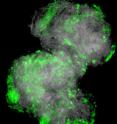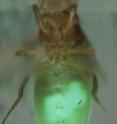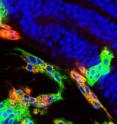Researchers create a fly to study how a normal cell turns cancerous
Related images
(click to enlarge)
The wing of a fruit fly may hold the key to unraveling the genetic and molecular events that transform a normal cell into a cancerous one. The study, conducted on Drosophila melanogaster by scientists at the Institute for Research in Biomedicine (IRB Barcelona) and led by ICREA researcher Marco Milán, has reproduced each of the steps known to take place when a healthy cell turns cancerous. The researchers have thus provided an inexpensive and effective model that will allow the scientific community to scrutinize the genes and molecules involved in each step. Given that the vast majority of genes in Drosophila are conserved in mice and humans, the results obtained may also lead researchers to perform similar studies in more clinically relevant models. Proceedings of the National Academy of Sciences (PNAS) has published the study online this week.
Argentinian scientist Andrés Dekanty, a Juan de la Cierva researcher in the Milán lab and first author of the article, explains that "for the first time we have a genetic model that allows us to understand the events that take place, starting from when cells begin to accumulate genomic errors until the development of a tumour." The Milán team began by provoking genomic instability in a selection of cells in the fly wing. They then prevented these cells, with an aberrant number of chromosomes (aneuploidy), from succumbing to the cells' natural defense mechanisms so that they would survive. From there, they observed that the cells spread throughout the tissue, became mobile, activated the growth of adjacent cells, and degraded the basal membrane that kept them in place, allowing them to break free and even invade nearby tissues. "All of these events are things that we see in cancer. This fly model will therefore help us to identify each of the genes and molecules involved in epithelial cell detachment (delamination), motility, abnormal growth, basal cell degradation and invasion," says Milán.
"This study takes things one step beyond, however," say the researchers, "and opens a fundamental conceptual debate." This is the first time that these phenomena have been described in relation to genomic instability. "This has allowed us to propose something that hasn't yet been possible to study in depth and that now should be taken into serious consideration. Is genomic instability the cause of tumorigenesis?" says Milán.
Genomic instability, a cause of cancer?
Cells in all human cancers display considerable genomic instability. Their genomes are full of mistakes. "If we can demonstrate this direct correlation, we will have something very specific to work with to find precise targets. Aneuploid cells don't exist in healthy organisms. If we can identify what differentiates a cell with genomic instability from a normal cell, we may be able to identify specific treatments," says Dekanty.
Today, cancer therapies are aimed at slowing proliferation, or cell division. A major problem with this is that all cells -- both cancerous and healthy ones -- divide. Treatments are therefore associated with many side effects. "There isn't a treatment available that attacks only the cells with genomic instability," say the researchers. "If we can clearly differentiate one from the other, we'll hopefully be able to find drugs that target them specifically," explains Dekanty.
Source: Institute for Research in Biomedicine (IRB Barcelona)
Other sources
- Researchers create a fly to study how a normal cell turns cancerousfrom Biology News NetThu, 29 Nov 2012, 23:30:55 UTC
- Newly created fly to study how a normal cell turns cancerousfrom Science DailyThu, 29 Nov 2012, 17:02:00 UTC
- Researchers create a fly to study how a normal cell turns cancerousfrom Science BlogThu, 29 Nov 2012, 15:31:01 UTC


